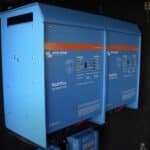
MENUMENU
TALK TO AN EXPERT
Special Hours: 7AM – 6PM PST
TALK TO AN EXPERT
Special Hours: 7AM – 6PM PST
When building a DC system for an RV, boat, or off-grid home, the big question is: do you really need 12V or 24V? For most small systems, 12V remains the standard. But as power needs climb—running larger inverters, motors, or solar arrays—24V becomes more attractive. In this guide, we’ll explain when each makes sense, the tradeoffs, and what you need to know. For even larger systems, you may want to consider stepping up to 48V.
Most cars, RVs, and boats utilize a 12-volt electrical system, although there are some exceptions. So, when are 12V vs 24V batteries used?
To understand more about batteries, we must first understand what volts or voltage is. Voltage is the amount of electrical pressure it takes to push an electrical current. Take a look at what volts are to get a better understanding of this concept.
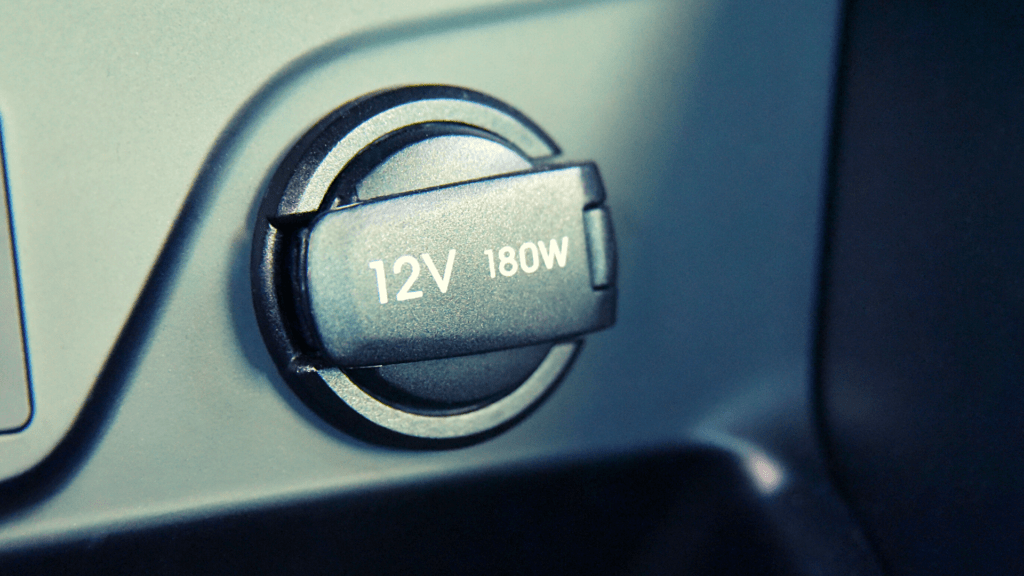
12V tells us that the battery supplies 12 volts under a nominal load. The same principle holds for a 24V battery bank in that it provides 24 volts.
As we discussed before, most car and RV batteries are 12V.
12V batteries are used in most vehicles because the electrical components such as the starter, lighting, and ignition systems are designed to operate on 12 volts.
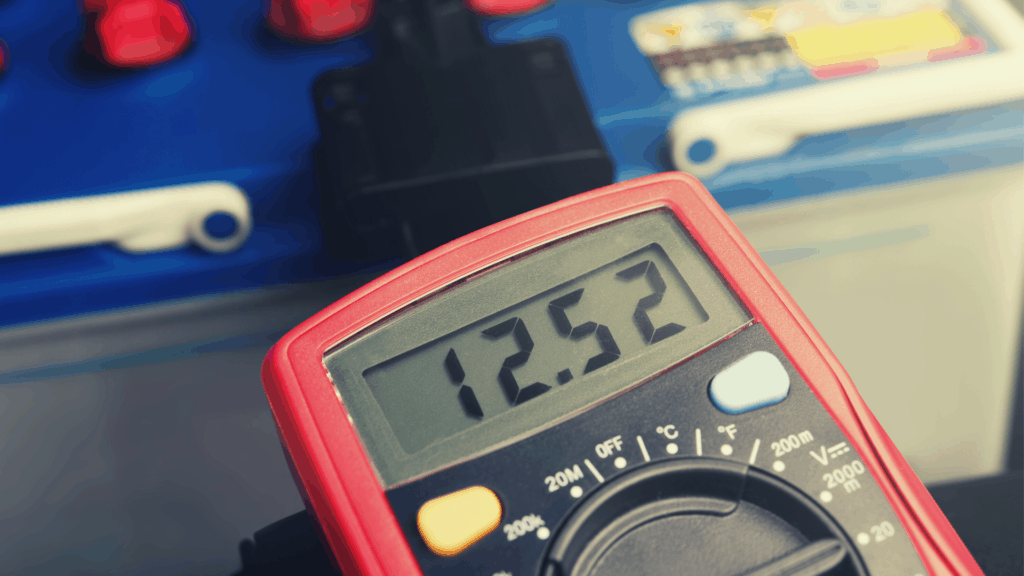
We sometimes use 24V battery systems in larger trucks and buses due to the vehicle’s higher power needs and long cable runs. You can also see 24V used in larger boats and some RVs with elaborate solar systems.
Another typical application for a 24V system is on trolling motors for fishing boats.
A 24V system is where you produce 24V under nominal load. There are a couple of ways to create a 24V power system. One way is to purchase a 24V battery. The other is to use two 12V batteries in series to create a 24V system. Let’s take a look at these options in a little more detail.
One way to create a 24V system is to use a 24V battery. 24V batteries are less common than their 12V counterpart. 24V batteries are also relatively expensive.
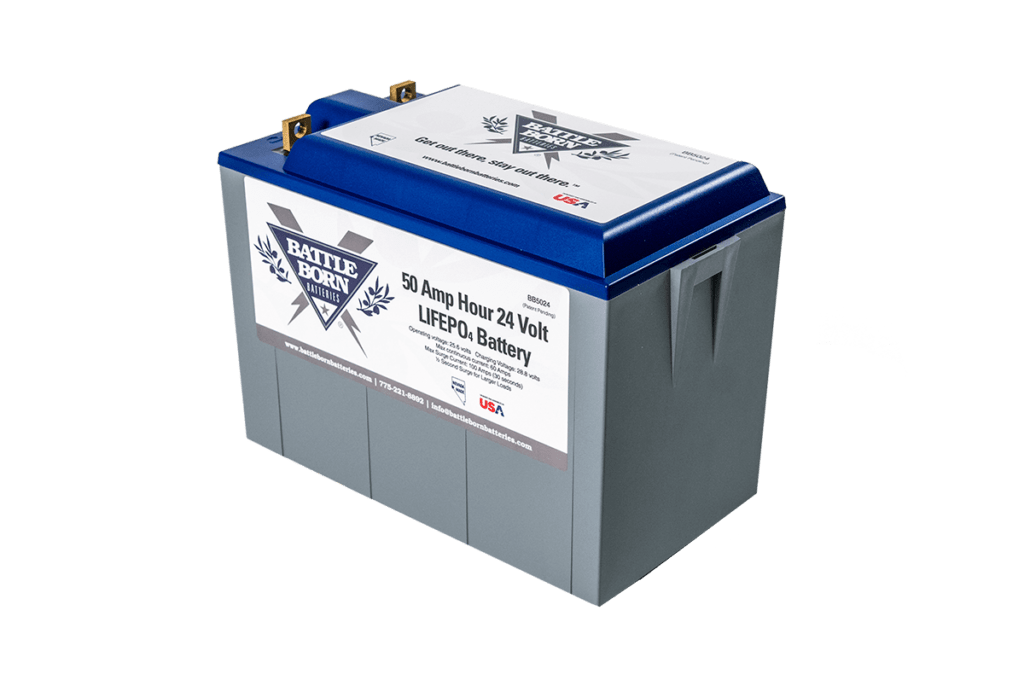
However, they do take up less space than running other batteries in series. So, if space is a concern, a single 24V battery may be a better choice for you.
↳ Click here to check out our 12V and 24V Battle Born Batteries product specs.
The most common method for building a 24V system is to run batteries in series.
Running batteries in series means they have a single electrical path equal to the sum of the system’s volts. So, if you have two 12V batteries wired in series, then 2x12V=24V.
To create a 24V system using two 12V batteries, you would wire the first battery’s “+” positive terminal to the “-“negative terminal of the second battery. The remaining negative and positive connections get wired to the component you want to power just as you would if you were using a single battery. You can accomplish the same thing using four 6 volt batteries.

To make this easier to digest, let’s look at something we are all familiar with, a flashlight. Many flashlights use batteries that are running in series. Suppose you have a large flashlight that uses four “C” size batteries.
When you install the batteries, they are in a single row with negative touching positive. This is a series circuit. Each of the “C” batteries is 1.5V. We learned earlier that when batteries run in series, then the output voltage is the sum. In this case, the flashlight runs off 6 volts.

When looking at 12V vs. 24V systems, there are some pros and cons to each system type. Let’s take a look at some of the pros of each.
As we talked about earlier in the article, 12V systems are relatively common. Most vehicles use 12V systems as components used in vehicles are designed to operate on 12V. The alternators generate 12V to charge the battery.
When it comes to RVs, most appliances such as RV refrigerators and all the lighting work on 12V as well. 12V systems only require one battery and work well for low-power applications and short wire runs.
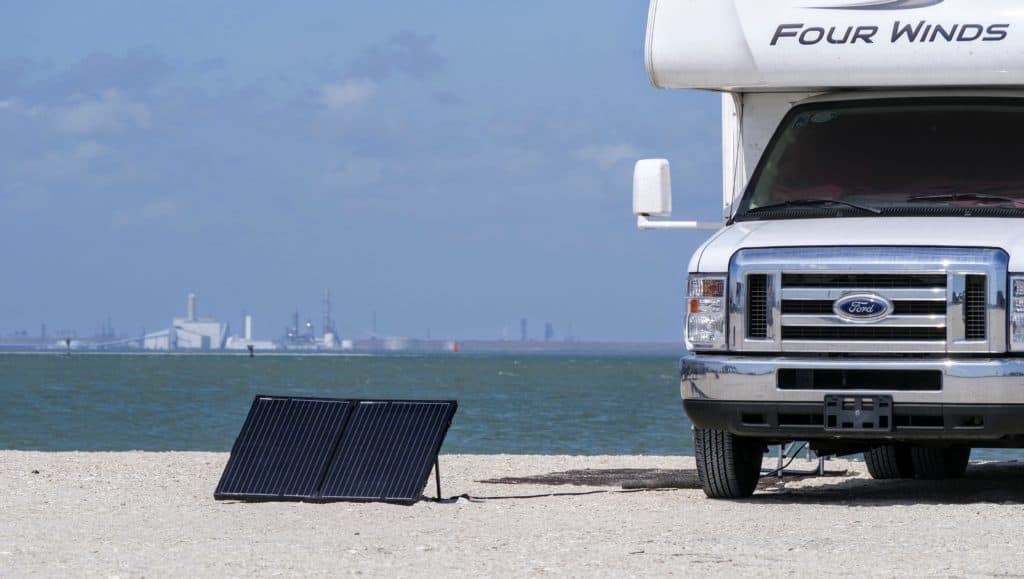
24V systems are beneficial because you can use smaller diameter wire and reduce amperage by two times. Using smaller diameter wire can reduce wiring costs and decrease the space needed to run wiring. This is especially important where long wire runs are required.
But wait, how can you run a smaller wire with more voltage?
You can actually run a wire 2x smaller than an equivalent 12V circuit. This is because the higher voltage requires less current to produce the same power. Since we are running less current or amps, we can use a smaller wire. This is the same reason power is transmitted on power lines at very high voltages. The wires can be much, much smaller and carry lots more power!
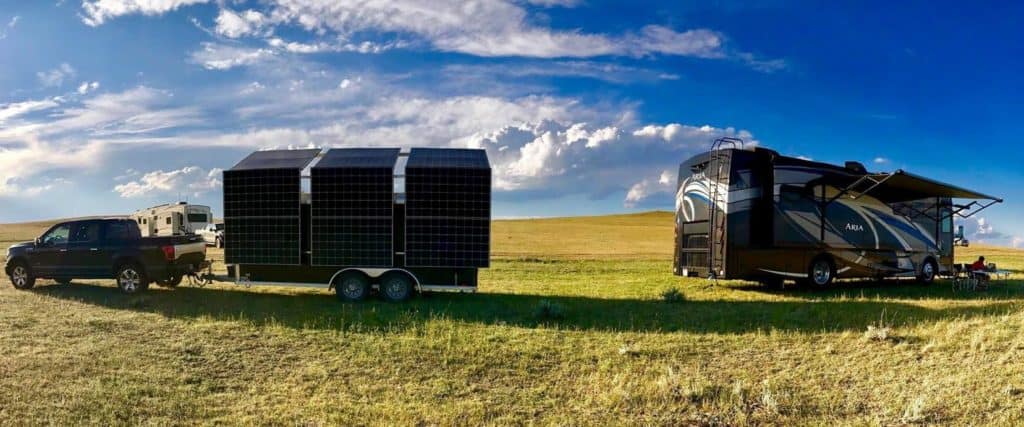
In addition to smaller wires, 24 volt systems operate more efficiently in motors and inverters. Often, the same solar charge controller operating on 24V vs 12V will handle twice the solar input.
As there are pros of 12V vs 24V systems, there are also cons to each type of system. Some of the pros of one system can become a con of the other.
12V systems require massive wires when pulling large loads because the current (amps) are higher. As we have already learned, 24V systems reduce the current or amps two times, then a downside of a 12V system is the amperage is double that of a 24V system at the same power.
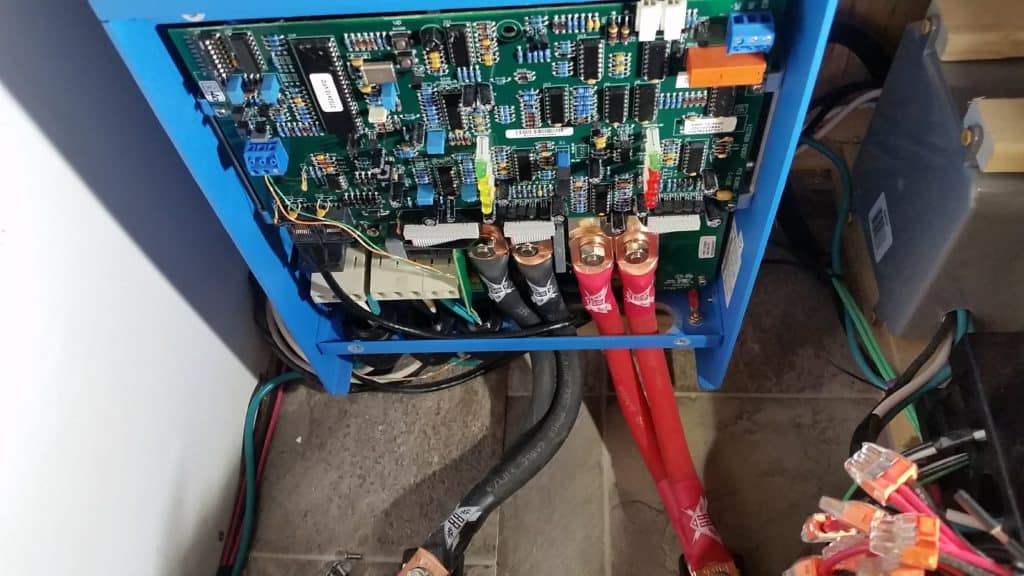
Because 12V batteries use two times the amperage at a given power draw, they are less efficient than a 24V battery due to resistive losses.
If you are using a 24V system in an application with 12V appliances, you will need a converter to reduce the voltage to 12V. The variety of components and devices that run on 24V are not as plentiful as what is available in 12V.
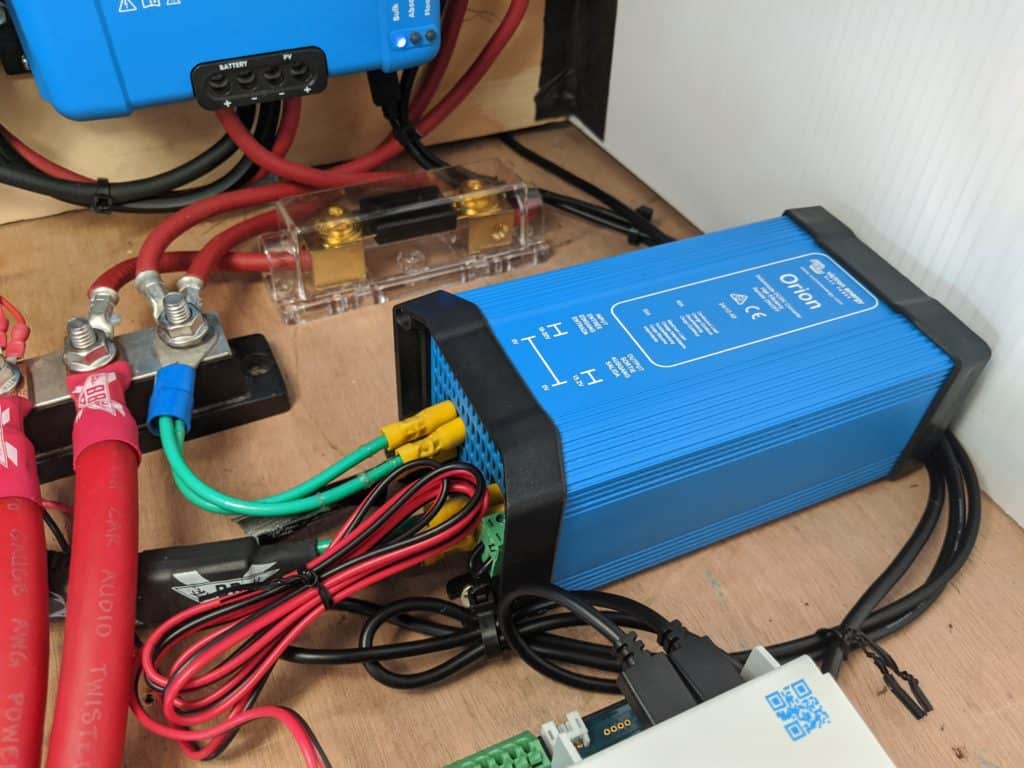
Although you can charge a 12V battery with the alternator of a vehicle, you won’t be able to do that directly with a 24V system if the chassis is a 12V system. Additional DC-DC converters are needed to accomplish this task.
Shore Power / Inverter-Charger: At 12V and 24V, inverter/chargers are common and easy to source. Most RVs, boats, and cabins use them for shore or generator charging.
Alternator Charging: A 12V alternator can directly charge a 12V battery bank, but charging a 24V bank requires either a 24V alternator or a 12→24V DC-DC converter. This adds complexity and cost. Alternativly a dedicated 24V alternator can be used with a dedicated controller like our wakespeed models.
Solar Charging: Higher voltage improves solar controller efficiency. For example, a 50A MPPT controller handles ~700W at 12V, but the same unit can handle ~1,400W at 24V. This makes 24V attractive for larger solar arrays.
Now that we have learned a little about 12V vs. 24V systems, we need to understand when we should use one over the other.
When building a DC (direct current) battery system, it’s crucial to understand your power requirements to run the appliances you need. The energy that is consumed by a device is measured in watts. Once you know your wattage requirement, you can determine what system is required.
If your requirements or your solar array are below 3000W, you can generally get by with a 12V system.

Many recommend 24V systems when your power needs are above 3000W or generating 3000W of solar or more. When you get to this point, the benefits of a 24V system outweigh the cons because you can run smaller and increase the system’s efficiency.
If your power consumption is even higher, above 6000W, you can benefit from an even larger DC system and consider stepping up to 48V.
Many DC MPPT solar charge controllers have higher voltage capabilities to handle higher panel voltages. They, however, have a hard current limit.
When using a 50 amp rated charge controller on a 12V battery bank, you can use the controller with 700 watts of solar. If you use that same charge controller on a 24V battery system, it can connect to 1400 watts of solar panels. This means that half the number of solar charge controllers is needed. They will also operate more efficiently at 24 volts.
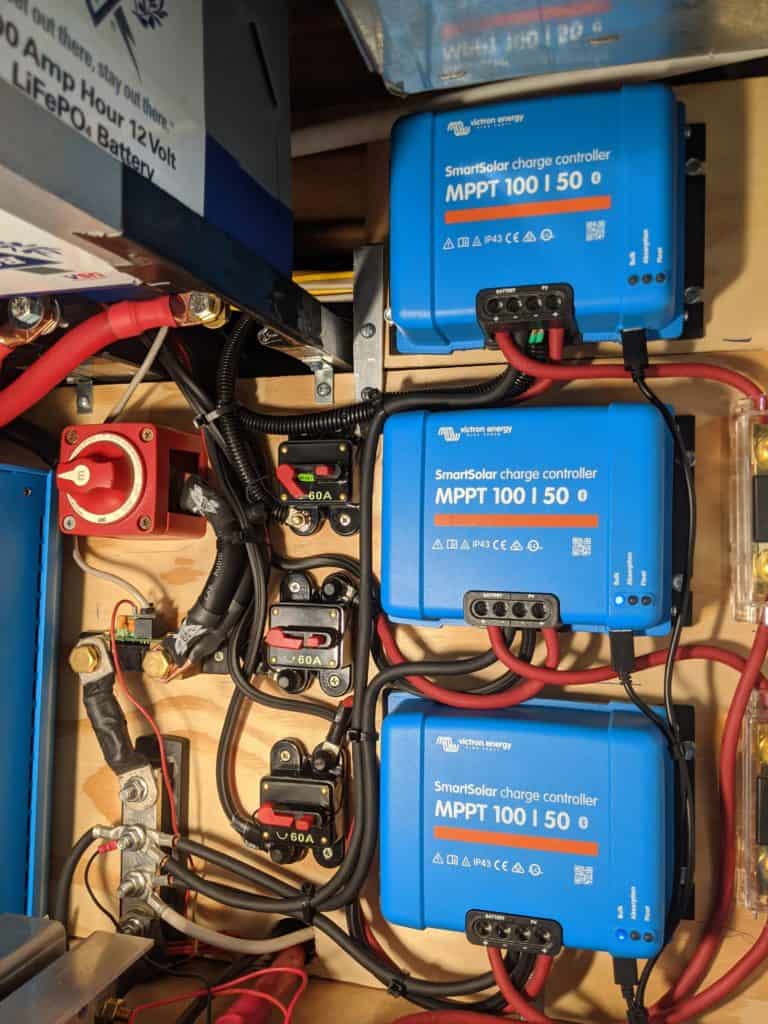
It isn’t always a clear-cut decision. There are many variables to consider when determining which one is the best choice. Here are some general application guidelines.
In RVs: Most RV appliances (lighting, fridges, pumps) are designed for 12V so sticking with 12V if possible is easiest. However larger RV’s running big inverters or large solar often move to 24V even with the added complexity and cost for the added high power benefits.
In Boats: Many boats run 12V for navigation and electronics, but trolling motors, winches, and HVAC benefit from 24V’s efficiency. A DC-DC converter is often used to step down to 12V for critical systems.
In Off-Grid Homes & Cabins: 24V can be a good fit for small cabins with moderate loads, especially where solar arrays exceed 1–2kW. But for full-time homes or power-hungry setups, a 48V system is usually the more efficient choice. Because homes rarely have 12V systems, 24 or 48V systems are the norm for stationary off-grid use cases.
📊 Comparison Table Update (replace “12V vs 24V, Which Is Right For Me?” section)
| Feature | 12V | 24V | 48V* |
|---|---|---|---|
| Common in RVs | ✔️ | Some | Rare |
| Wire Size | Largest | Smaller | Smallest |
| Appliance Compatibility | Widest | Moderate | Few |
| Efficiency (Large Loads) | Lowest | Medium | Highest |
| Best For | <3kW systems | 3–6kW systems | >6kW systems |
There’s no one-size-fits-all answer. A 12V battery system is simple, widely compatible, and perfect for smaller RVs, boats, and off-grid setups under ~3kW. A 24V system makes sense when your solar array or inverter grows beyond that range, offering efficiency gains and lighter cabling. And if your energy needs climb even higher, a 48V lithium battery bank may be the most cost-effective and future-proof solution.
At Battle Born Batteries, we design systems for every level—12V, 24V, and 48V. Our technical team can help you match the right voltage to your lifestyle and build a safe, reliable setup that meets your needs today while preparing you for tomorrow.
We know that building or upgrading an electrical system can be overwhelming, so we’re here to help. Our Reno, Nevada-based sales and customer service team is standing by at (855) 292-2831 to take your questions!
Also, join us on Facebook, Instagram, and YouTube to learn more about how lithium battery systems can power your lifestyle, see how others have built their systems, and gain the confidence to get out there and stay out there.
Shop Best Sellers

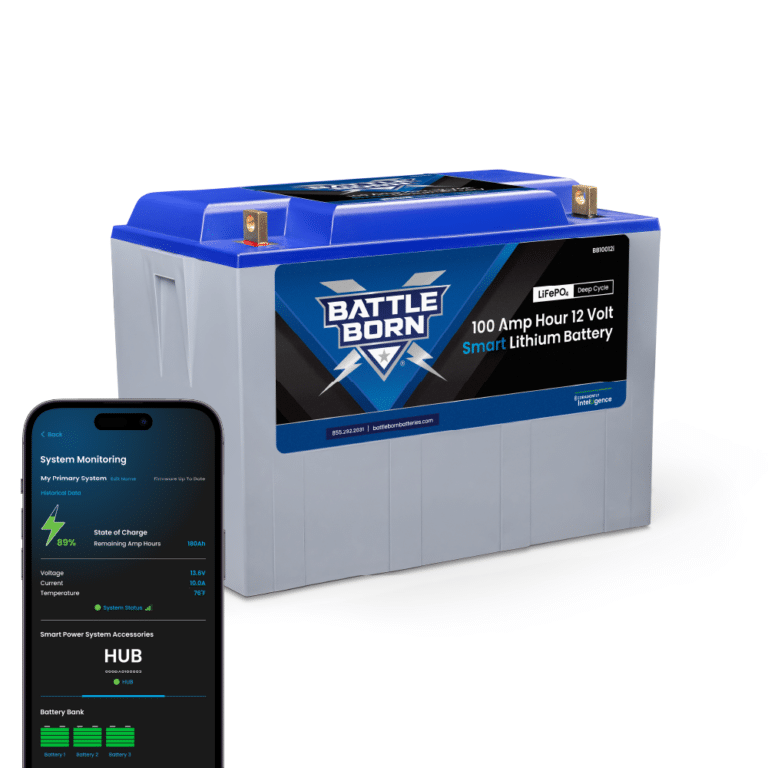

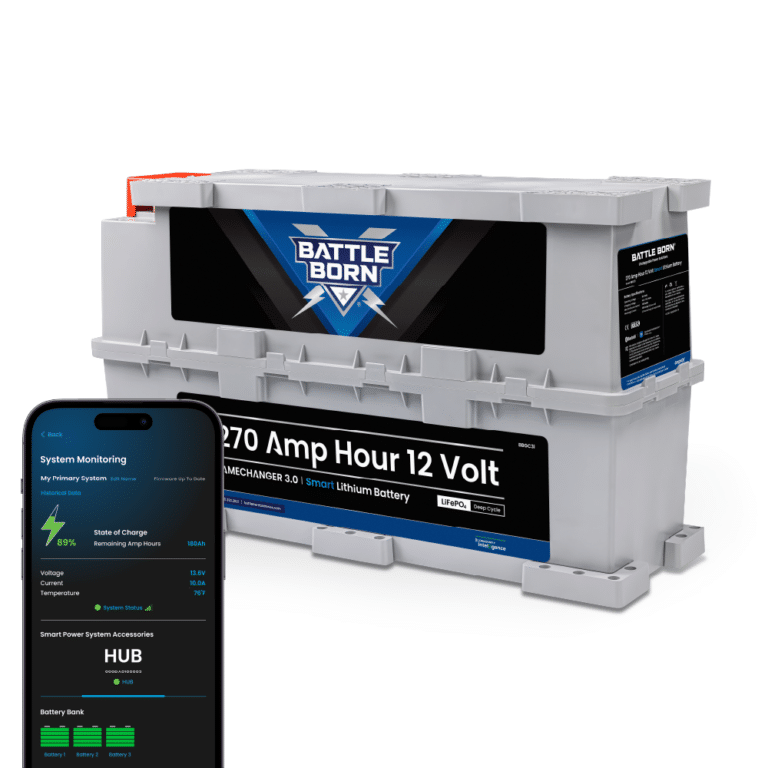




Ask a technical specialist now at 855.292.2831
Stay in the Know
14 thoughts on “12V vs 24V: What’s The Difference in Battery Systems?”
Nothing was mentioned about a 24V system operating with 6V batteries and having to remove 4 batteries when 1 battery fails, as apposed to 2 batteries with a 12V system. The conductors are purchased once but the batteries can be purchased several times over the life of the charger/inverter. I guess it’s only money and there won’t be a U-haul behind my Hertz.
Hi there, thanks for your feedback and we will consider creating content around this topic in the future. If you have any additional questions please give our team a call at 855-292-2831.
Very helpful. I just bought an unaltered 2012 MB Sprinter 3500 to travel. Right now, the inverter is too small for my needs. Induction plate, other standard 12V loads but I also want on-board air (VIair) and a small welder that draws 2100watts. Hoping to put 600-630 watts of solar panels on the roof. I’ll reach out to you.
Hi Tony! That’s great to hear, we always appreciate hearing feedback from customers. We look forward to assisting you very soon!
I have a 3 – 100w solar panel system that runs fans, pumps, etc for my backyard greenhouse. The panels require a wiring run that is 25-30 feet so, loss rate could be high. I would like to run these panels in series vs parallel (current config) which will approximate 63v (21v x3) @ 5a. If I do so with my battery configuration (2 AGM – 100ah batteries in parallel – 12v), I will be bumping up against the max v-in for my solar controller at 12v. If I wire the batteries in series (24v), the controller can handle far more v-in. Since things in the greenhouse run on 12v and my current inverter is 12v to 120v, I will need a 24v to 12v regulator. Is this the optimum configuration for my situation?
* long wire run = voltage drop at 12v
* MMPT controller says
– 60v-in max (900w) at 12v
– 72v-in max (1400w) at 24v
* (3 solar panels in series = 63v @ 300w
* Inverter is 12v in and other fans are 12v, so voltage reduction required (2-4% loss???)
Hi Brian, thank you for reaching out. Our team needs a few more details so if you could please give them a call at 855-292-2831 they will be more than willing to help you out with the configuration.
I will be purchasing a 200 watt portable solar panel kit and using two 12 volt batteries for my RV. Which is my best option to run lights, fan and TV? I understand I may need an inverter.
Hi Wyatt, thanks for reaching out. Our team would need more information about the system and the rig you have, so if you could please give us a call at 855-292-2831 we can further assist.
Which voltage is better between 12v and 24 v in rv a/c (1800w,1400 BTU)?
Hi Ju, thanks for reaching out. Our team notes that 12V is much more common and a growing trend. Typically, the startup wattage required ranges from about 1,000 watts on a 5,000 BTU AC unit to 3,500 watts on a 15,000 BTU unit.
Once your AC unit is running, it requires much less power. On average, a 5,000 BTU unit needs 300-450 watts, while a 15,000 BTU unit needs about 1,500 watts. 12V air conditioners are much smaller and typically run between 300 and 600 watts. These, however, do not require an inverter and can be connected directly to the battery system because they run on DC power.
We explore this topic in the blog here: https://battlebornbatteries.com/run-rv-ac-unit-on-lithium-batteries/ so if you have any additional questions please feel free to reach out. Thank you again!
Hi Nikki,
Is 2 * 100ah 12v batteries equivalent to 100ah 24v or 200ah 24v?
Hi there! 2 100Ah 12V batteries can be wired in series to create a 24v 100ah bank. This is reflected in the diagram located in the “How Do You Connect 12V Batteries In Series?” section of the blog.
I am leaning towards a 24V system for my van that I am planning out. It will include a DC A/C (either 12V or 24V) and 120VAC kitchen appliances including a 1500W induction cooktop as well as charging from a second alternator that can supply 150A at 24VDC. What is the best way to put together a battery bank for 24VDC that can support 150A continuous charging and 125A continuous discharge? I would like around 7-10kWhr of storage. Thanks!
There are more distinguishing features between 6V and 12V RV batteries than just voltage. All in all, a 12-volt battery system is for those who don’t mind the extra weight and space requirements. However, for RV owners who want to save as much space and weight as possible, a 6-volt system is the perfect fit. It is also more compact and lighter than the 12-volt unit.